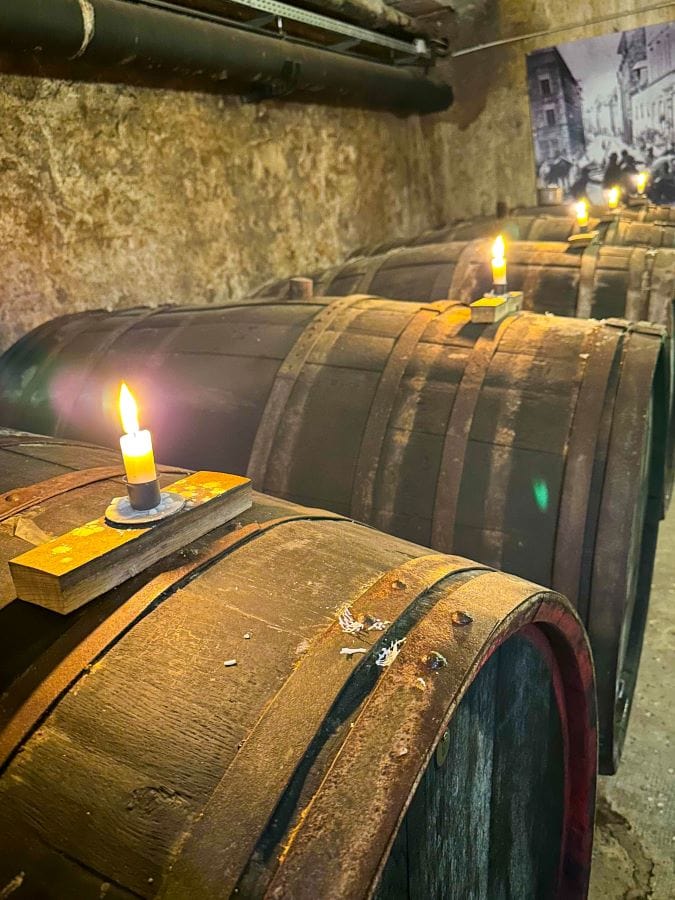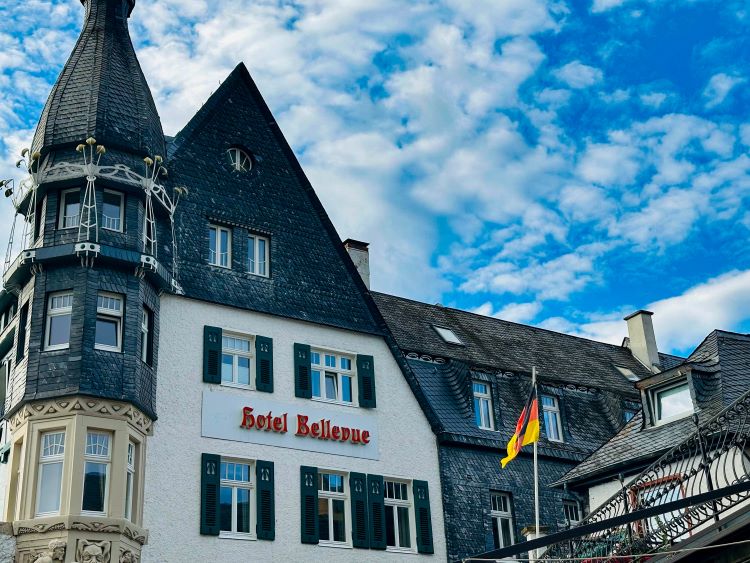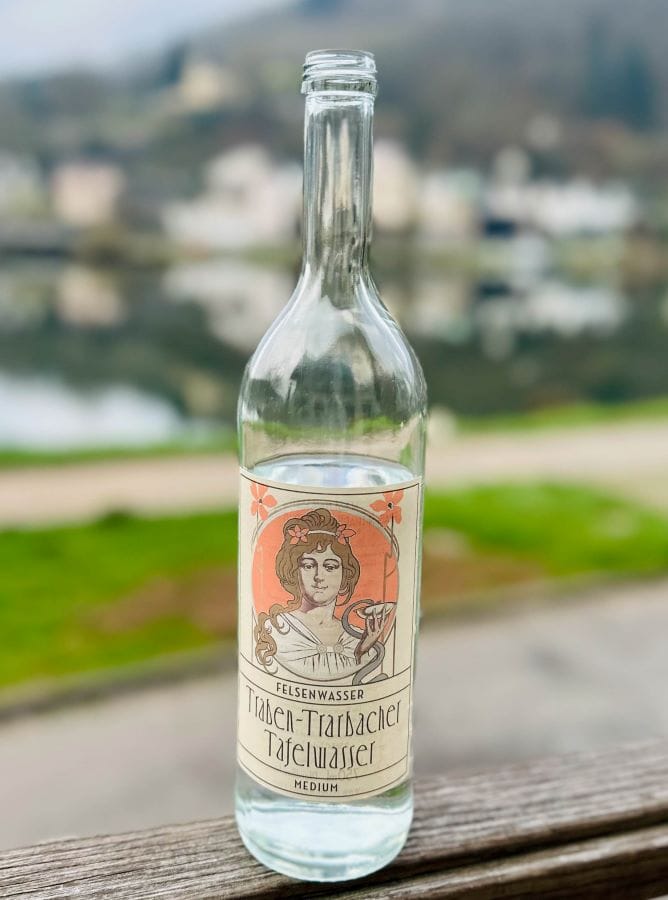
Bells tolled to announce the morning as I sipped coffee on my private terrace at Hotel Bellevue, overlooking the Mosel River in Germany.
As the sun rose and the sky turned shades of lavender, walkers strolled the promenade next to the river. The village of Traben-Trarbach was waking up.
Located in southwest Germany, Traben-Trabach may not be as famous as villages such as Heidelberg, yet the friendly town of 5,000 boasts its own appeal.
Mosel Valley is Riesling Country

The region’s favorite grape brought a burgeoning wine trade to the area in Roman times. Today, Riesling grapes account for over 60 percent of the vineyard lands. Locals passionately extol the qualities of the luscious grape and their beloved beverage.
Guide Peter Storck, who led us on a tour of one of the town’s historic wine cellars, said with gusto and adoration, “This wine is crispy, fruity, and dancing on your tongue.”
Traben-Trarbach in Germany’s Mosel Valley

A scenic 90-minute drive from Frankfurt, Traben-Trarbach feels like a different century.
We still observe the “old ways,” one person said, describing the village.
Gentlemen often wear a coat and tie to breakfast, and guests dine by candlelight not only at dinner but also at breakfast and lunch.
Another guest noted that being in the village felt like the 50s or 60s, adding, “It’s so quiet and refined.”
Historically, Traben and Trarbach were separate villages, one on each side of the Mosel River.
Both towns flourished due to their strategic location, but Traben and Trarbach merged in 1901 as transportation and communications increased. The intent was to streamline the government and strengthen the community.
Still, one resident joked that he rarely goes to the “other side” of the river.
Luxe Lodging

Even though Traben-Trarbach has a population of only 5,000, visitors will find luxe lodging such as Hotel Bellevue and Moselschlὂsschen Spa & Resort. Situated just a five-minute stroll apart, both feature superior accommodations, fine dining, and exquisite spa facilities.
Hotel Bellevue, where I stayed, dates back to 1756. Over the years, the property has endured fires, floods, and wars.
Owner Matthias Ganter, who has owned the property since 2000, named the property “Romantic Art Nouveau Hotel Bellevue.” Under Ganter’s management, the Bellevue, which is how most people refer to it, has been recognized for its excellence.
The Bellevue’s uniquely designed suites tell a different story, with furnishings for art, music, and literature aficionados.
Hotel Bellevue Suites Each Tell a Story

The Belle Époque suite, my favorite, featured a whimsical lamp with delicate plumage in blush tones, plush furnishings, and a stunning view of the Mosel River.
La Belle Époque,” meaning “the beautiful age” in French, refers to a period in European history from 1871 to 1914 when peace, economic growth, and the arts flourished.
The Bellevue’s award-winning restaurant, Belle Époque, serves a classic-modern culinary style inspired by French cuisine.
The popular restaurant also has an extensive wine selection. And that includes wine at the breakfast buffet.
For the Love of Riesling

In the Mosel Valley, the Riesling grape is king. The grape accounts for 62 percent of the vineyard land. Sommeliers worldwide often place Riesling at the top of the world’s list of best white wine grapes.
Harald Bacher, our guide for a tour at Bremmer Carlmont, described the vineyard as “the steepest sloped vineyard in the Mosel Valley.” He also shared how much Riesling is beloved.
“They say that people here drink one glass of Riesling at breakfast and two at lunch,” Bacher said, adding with a smile, “We don’t count at dinner.”
Dining in Germany’s Mosel Valley

A three-minute stroll from Hotel Bellevue sits Die Mosel, an inviting tapas bar and my favorite place for casual dining in the village.
The flicker of candles, even midday, created soft shadows along the rustic walls and wooden furniture. Aromas of spices, the hum of conversation and laughter, and seemingly endless bottles of wine—their labels rich with stories—enchanted.
The wine bar serves extraordinary tapas family style. But it was the welcoming vibe and charming husband-wife owners that impressed. And the squiggly blue line on the floor.
Read More: Exploring Franconian Wine Country: Germany’s Best-Kept Secret
Husband and Wife Owners Charm Guests

Owner Manuel Stolte proudly explained that the lit, meandering blue line denotes the Mosel River.
“And it’s accurate!” he added.
In addition to the impressive wine list, the menu includes food like fried gnocchi, olives, edamame, and camembert. And of course, wurst.
Diners can savor a chocolate brownie with mascarpone crème for dessert.
Day Trip to Trier from Traben-Trarbach

From Traben-Trarbach, it’s less than an hour’s drive to Trier, the oldest city in Germany. Just across the border from Luxembourg, Trier has well-preserved monuments that have earned the city UNESCO World Heritage status.
The Porta Nigra, a Roman city gate that dates to the second century, is an architectural treasure and one of the city’s landmarks. Trier is a university town with a youthful energy and fun restaurants, such as Hotel Restaurant Biesius Garten.
Amphibious Adventure: Where the Road Ends and the River Begins

Amphibious car enthusiast Jürgen Neuenhausen took three of us for a ride in his car-turned-boat one splendid sunny afternoon in Trarben-Trarbach.
The Amphicar, produced in Germany from 1961 to 1968, is described as “an amphibious automobile that functions as a car on land and a boat on water”.
Riding in an amphibious car on the Mosel River was more fun than I had ever imagined.
We drove down the town’s cobblestoned streets, came to a landing, and drifted effortlessly into the river.
Landlocked No More

Observers on the banks of the river waved and clapped as we floated by in our “car,” and we waved back as if we were royalty.
“And what would a day be on the Mosel without some Champagne?” Captain Neuenhausen asked rhetorically as he popped the cork and poured a flute for us.
For the record, the captain did not imbibe. But he did charm us with his wit, knowledge, and sense of fun.
“Anyone get their feet wet yet?” he asked with a smile, knowing the answer would be, “Of course not!”
Captain Neuenhausen named his amphibious car Aloha and decked it with a Hawaiian lei hanging on the rearview mirror and a rubber ducky in a life preserver on the dash.
Basking in the sun, sipping Champagne, and gliding past historic architecture, I felt like the envy of those on land, admiring our blissful adventure.
So Much to Love about Germany’s Mosel Valley

On my final morning in Traben-Trarbach, I settled into my favorite place on my terrace and watched as the sun began to illuminate the river.
The sleepy village, ancient sites, and fruity wines had won me over.
A woman walking her dog along the promenade noticed me, smiled, and lifted her hand in a friendly wave. I smiled and returned the gesture.
People, without exception, were welcoming and gracious. It was just one more thing to love about the Mosel Valley.
If You Visit Germany’s Mosel Valley
Visit Hotel Bellevue and Moselschlὂsschen Spa & Resort to reserve a room at either property.
For the most up-to-date information about the Mosel Valley, visit Germany Travel.
Inspire your next adventure with our articles below:
Want to discover more hidden gems and helpful travel tips? Join our free newsletter for the latest travel secrets and travel articles.
We are reader-supported and may earn a commission on purchases made through links in this article.
- 7 Enchanting Reasons Victoria, BC Should Be Your Next Getaway - June 19, 2025
- Colorado’s Grand County Wonderland—Where Alpine Lakes Meet Small-Town Magic - June 4, 2025
- Germany’s Mosel Valley: A Riesling Lover’s Paradise - May 15, 2025
